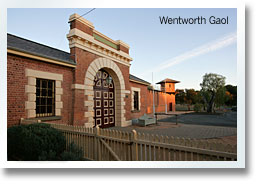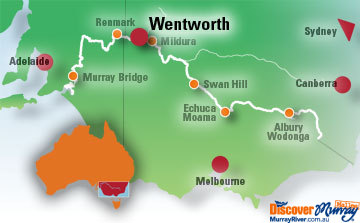
Wentworth, NSW gateway to the Outback and Mungo National Park

Wentworth - Where the Darling meets the Murray
Discover the Darling River Run
The outback town of Wentworth lies at the junction of the Murray and Darling rivers. Wentworth retains many historic buildings, including the Old Gaol, the Courthouse, the Convent and the Customs House (now a private residence). Snake Island is the name given to the sandy shoal between the two rivers. A canoe tree is located nearby and the area is a nature reserve, rich in flora, wildlife and birdlife.
At Buronga, the Australian Inland Botanic Gardens feature arid land plantings. The gardens are open every day but once a month can be toured by tractor train. Mungo National Park lies about 150km northeast of Wentworth. The park features the Walls of China, spectacular sand dune formations, and several graded walks. Source
Wentworth is sited on the junction of the Darling and the Murray rivers in the Murray Basin. The Darling has its headwaters and tributaries fed by monsoonal downpours and mountain rains in north-eastern New South Wales and southern Queensland. It meanders over the imperceptibly sloping plain, but when in flood becomes an inland sea. From the junction it extends some 1900 km, in a good season, to Walgett.
In the 1890s there were 92 paddle steamers working the Darling, and between 1890 and 1900 Wentworth became the largest river port in Australia with over 400 craft using it in a year. Captain Charles Sturt named the Murray River on 23 January 1830 from the vantage point of the junction of the rivers. Earlier in 1829, Sturt explored the Darling River headwaters. Sturt also previously passed the junction of the Darling with the Murray when he was on his epic journey down the unexplored Murrumbidgee-Murray River system.
Wentworth was declared a town in 1860, and on New Years' Day in 1861 the first race meeting was held. The course was the town's main street, the finishing post a hotel flagpole and the balcony of the same hotel became the grandstand. After just two years, in 1862, Wentworth became the centre of the mail network for western New South Wales. The runs were Wentworth- Melbourne, Adelaide-Wentworth via the Murray, Wentworth-Balranald (via Hay) to Sydney and Wentworth-up the Darling via Bourke. View assessment of Heritage items in Wentworth Shire region.
Places of Interest around Wentworth
Old Wentworth Wharf
The wharf became the nucleus of the town and the region, where bullock teams hauled in the wool from outlying stations to load on board the steamers and barges. The port was a busy one; in fact in 1890 in one week alone some 31 steamers were tied up at the wharf. The exports that year were valued at £1 276 202 and imports worth £654 042, which on any standard were huge sums of money. Wentworth's Customs Office was the busiest in New South Wales outside Sydney and Newcastle. A total of 420 boats steamed into Wentworth in 1890. In some years these craft shipped over 12 000 bales of wool from the Darling River woolsheds.
Wentworth & District Sporting Club
Beverley Street. Fully licensed clubhouse open 7 days a week together with an 18-hole golf course, 2 bowling greens, 14 tennis courts.
Lock 10 and Weir
Off Cadell Street, Wentworth. Constructed in 1929, it is 827 km from the mouth of the Murray, and the pool level is 30.8 m above sea level. Picnic and barbecue facilities.
St Ignatius Convent School
On the way to Lock 10 in Cadell Street. This delightful small building built of local timbers was in use as a school between 1911 and 1950. It was restored by the National Trust (NSW) in 1988. Not open for inspection.
Junction Park
Off Cadell Street. This park abuts the junction of the Murray and Darling rivers. A monument to the overlanders/ explorers Joseph Hawdon and Charles Bonney is within the grounds. Hawdon and Bonney crossed the river with their mob of cattle just downstream from the junction on 1 March 1838.
Sturt's Tree Wentworth Caravan Park
Off Darling Street. The plaque reads 'In late January 1830 Capt. Charles Sturt in his Whaleboat weighed anchor opposite this tree. He hoisted his flag to celebrate the discovery of the junction of the Darling and Murray Rivers.'
Thegoa Lagoon
Thegoa Lagoon and Reserve is highly significant to the Aboriginal community due to its location at the junction of the Murray & Darling Rivers. In the past, Thegoa was an important meeting place and food resource. The area contains numerous sites including burial sites, scarred trees, middens and campsite remnants. More.
Perry Sand-Dunes
Situated 6 km west of Wentworth just off the Old Renmark Road, the red, sandy dunes reach heights of 20 m and are remnants of past geological times. The area has separate conservation and recreational areas set aside, where off-road vehicles can be used.
St John's Anglican Church (1871)
Darling Street. A simple building, constructed of brick with rubble stone infill, in the Gothic style with entrance porch and steeple, is classified by the National Trust. Many of the clergy in the early days travelled into the Darling country, as far north as Wilcannia. They travelled by buggy with an Aboriginal guide to the station homesteads. When fresh horses were needed, they were borrowed from the station while others were rested, to be swapped over on the return trip. All along the track the vicars performed marriages and christenings as well as services.
Fotherby Park
Off Silver City Highway the park is a constant reminder of the river-boat days as it contains the Ruby, once the fastest passenger/cargo paddle steamer on the Murray. It was constructed in 1907, worked the river until 1941, became a houseboat until 1960 and then was dry-docked in the park in 1969. A restoration program is now underway. Admission by donation. Across the park from the Ruby is the 'Demon', a 8 horse-power steam engine used by the Chaffey brothers in the 1900s in land-clearing and water pumping. The park also features a life-sized bronze monument to the 'swaggie', in this case 'Possum' David James Jones, who roamed the bush and the Wentworth area for close on 50 years. Barbecue and picnic facilities.
 Old Wentworth Gaol (1879-81)
Old Wentworth Gaol (1879-81)
Beverley Street, features prison displays of the 1800s through to the 1900s. Designed by the Colonial Architect James Barnet it has a central exercise yard and 6 m high red brick walls around the perimeter. It also features a series of watch towers and pavillions with hipped slate roofs. The gaol inmates came from as far afield as Broken Hill and Wilcannia. It was closed as a gaol in 1927, and reopened for a short time in 1962 when fruit-pickers proved troublesome. The building is classified by the National Trust as being essential to Australia's heritage as its best example of a small gaol of the Victorian era in NSW. On display is the Morrison Collection of Australiana including bottles, antiques and artifacts. Open: Mon-Sat 10am-5pm. Admission charged. More.
Court House (1880s)
Darling Street. Constructed of brick with encircling verandahs. The main roof is of slate with consoles supporting wide eaves.
Pioneer World
Beverley Street, Wentworth opposite Wentworth Gaol. On display is a 25-year-old Murray cod that weighs some 25kg. It was still a baby, as some cod survive to 60 years old and weigh up to 150kg. A photo-graphic display features the history of the Murray-Darling rivers as well as hundreds of paddle steamer photographs and artifacts. Open daily 10am-5pm. Admission charged.
Lake Nearie Nature Reserve
An anabranch of the Darling River, 90 km north of Wentworth on the Old Roo Roo Road. The reserve is some 4 850 ha and is an excellent habitat for eastern grey, western grey and red kangaroos as well as numerous species of birdlife. It also has excellent examples of vegetation including grasslands, mallee, and shrub areas. Red gum, black-box, mallee and wattles occupy drainage depressions.
Scotia Sanctuary
The Scotia Sanctuary is the largest of the privately-operated Earth Sanctuaries Project and is located approximately 146km north-west of Wentworth. It offers homestead and shearing-quarters accommodation and exploration of the sanctuary by tour guides. Experience the life and wildlife of mallee sand-dune country of south-western New South Wales. Access is via Silver City Highway, then at 140 km turn west to Springwood, and continue north west to Tararra Station.
Renmark (Down River) - Merbein or Mildura (Up River)
Lake Victoria (Water Storage)
|
Wentworth Visitor Information Centre 66 Darling Street, Wentworth NSW |
Explore Wentworth
Expand MapTell your friends you found this at murrayriver.com.au!
Copyright Discover Murray 2025. This site or any portion of this site must not be reproduced, duplicated, copied, sold, resold, or otherwise exploited for any commercial purpose that is not expressly permitted by DISCOVER MURRAY.






 CREEDENCE CLEARWATER COLLECTIVE
CREEDENCE CLEARWATER COLLECTIVE An Afternoon Of Classical Piano
An Afternoon Of Classical Piano Angove Family Winemakers Art Exhibition featuring Wendy Neal
Angove Family Winemakers Art Exhibition featuring Wendy Neal A Celtic Christmas by A Taste Of Ireland
A Celtic Christmas by A Taste Of Ireland

